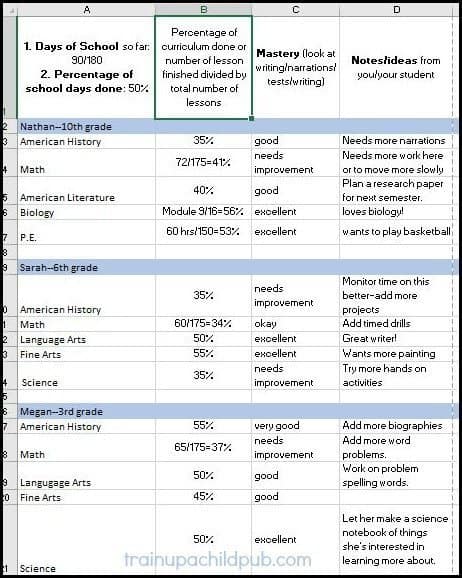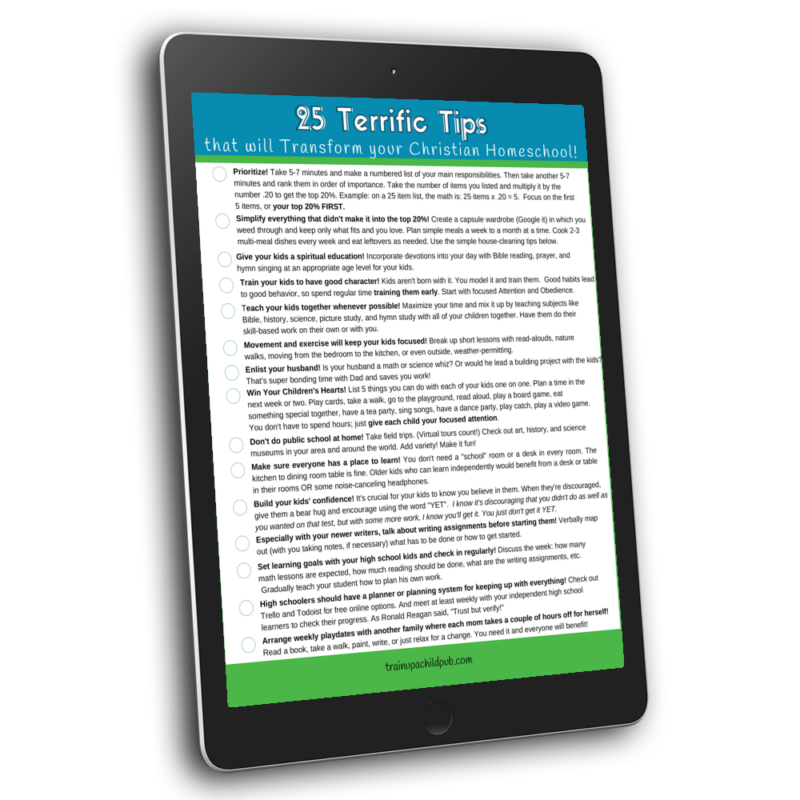How to do a Simple Mid-year Homeschool Assessment

Do you have a built-in system for keeping yourself and your kids on track with your homeschool goals? Or do you have much more school to do at the end of your home education year than you expected? If you don’t have a system to keep on track, I have one for you! Here’s how to do a mid-year or end-of-the-year homeschool assessment.
TABLE OF CONTENTS
- The Beginning of the Year is Always Exciting
- This is Why I Had to Start Doing a Mid-Year Assessment
- Here’s Why You Should Do a Mid-Year (or End of the Year) Homeschool Assessment
- Mid-year/end of year homeschool assessment: Step 1 – how are you doing at accomplishing your academic goals?
- What You’ll Find Out by Doing a Simple Homeschool Assessment
- Step 2 – Are Your Kids Retaining What They’re Studying?
- What if they’re not retaining what they’ve been taught?
- Ask Them What They’d Like to Do.
- Step 3 – If you’re behind… analyze WHY.
- What’s getting in the way?
- Do you have things on your list that ARE under your control?
- Step 4 – Create strategies for improvement.
- Common Household Issues-Not planning meals in advance.
- Common Household Issues-Unorganized
- How to Get Organized.
- Should you make time for a mid-year or end of the year homeschool assessment?
Doing an assessment like the one I describe here at the end of the semester or year will help you:
You can’t improve what you don’t evaluate!
Editor’s Note: There are a couple of affiliate links contained in this blog post. Should you buy something using one of our links, we may make a small commission at no extra cost for you. Thank you from the bottom of my heart for supporting us in this way!
The beginning of the year (or semester) is always exciting.
You know most of us begin our homeschool year by just jumping right in, assuming we’ll be able to finish our books and plans by the end of our school year. We are all so excited about the luscious new books, curricula, and shiny, pristine school supplies, we can’t wait to get started.
And then your first day (or first day back) of homeschooling arrives and you’re drinking out of a fire hydrant (again).
And suddenly it’s spring again, the weather gets balmy and bright…and everyone’s ready to be finished with school.
But sometimes there’s are a few things we need to figure out before we can be “done.”
What will you do when your fourth-grader still has a third of his math text to finish? And your 9th grader needs to read one more book and write an essay on it before she can finish her high school English?
After we had to continue our homeschool year into the summer for a few years, I realized I had to learn to manage our time better. And not wait until the end of our homeschool year to discover we were more behind than I expected.
Getting through your books and lessons always seems to take longer than we think, right?
And during your homeschool years there’s always the unexpected.
There are illnesses, unexpected company, sudden trips to help aging parents, and the other interruptions that just come from living life.
And it seemed as though I either overestimated what we could do or I underestimated how long it would take to get done. Or both!
And this is why I had to start doing a mid-year homeschool assessment.
The longer I homeschooled, the more I realized that I had to address the way I managed everything. I had to consider homeschooling, home management, my work life, and my personal life, and figure out how to make it all work together in a way that kept my sanity intact.
I had to learn take responsibility for managing instead of being dragged along by my hair.
Eventually, I came to believe that you could bring your kids’ homeschool education to life, manage your other responsibilities, and still have a happy, thriving home. But the keyword there is “manage.” Not let everything just happen on its own.
I discovered that if I actively managed homeschooling, my home, part-time job, and our family schedules, everything went more smoothly.
And that meant making hard decisions sometimes about what activities I could be involved with and what activities the kids could do.
Eventually, when the unexpected came (and it always does), I was more prepared and had more margin to deal with it.
So, If I knew early enough into the year that we were getting behind, it took a much smaller adjustment to get back on track than it would have if I’d waited until the end of the homeschool year.
Here’s why you should do a mid-year (or end-of-the-year) homeschool assessment
By learning how to do a mid-year homeschool assessment with my kids, I no longer came to the end of our homeschool year with lots of homeschool work left to finish in the summer. (Now if you’re a regular reader, you know I’m a big proponent of practicing math, reading, and writing during the summer. Summer learning loss is a real thing! Read more about it here and here.)
But ideally, you’re not just finishing the curriculum during the summer that your kids didn’t finish during the homeschool year. Getting your kids to continue doing some reading, writing, and math during the summer doesn’t mean just continuing your regular lessons.
For one thing, YOU need a break!
Secondly, your kids need a break, too. When you can keep their skills up more by “real life” activities than by using the curriculum they’ve been working on for almost a year already, they’ll feel they’ve had more of a summer break.
So think of doing a mid-year homeschool assessment as an antidote for “summer (home)school”!
But what if you already homeschool year-round? Then the summer doesn’t matter so much. But if you find yourself getting further and further behind that you’re comfortable with, you still might consider doing a homeschool assessment mid-way through your year just to course-correct more easily if you want to.
After all, if you are even a little more organized, a little more on top of things… then when there are sudden interruptions in your day, week, month…. it’s easier to course-correct without quite the overwhelm you have when you are waaay behind.
So, keep reading to see how to do it and see how to create a form to help you do it!
What you’ll find out by doing a Simple Homeschool Assessment.
Doing this mid-year (or end of the year) homeschool assessment will help you:
You’ll feel so much more energized and organized instead of flying by the seat of your pants and hoping you’ll get done with school on time.
Also, you’ll have a chance to identify and fix some of the issues that held you back last semester or at the beginning of this semester.
So, instead of constantly putting out fires, you’ll be able to be so much more intentional in the way you spend your time.
You will feel calm, confident, and more in control.
So let’s get started!

Mid-year/end of year homeschool assessment: Step 1 – how are you doing at accomplishing your academic goals?
Let’s start our homeschool assessment with the academics. How’d everyone do last semester? You’ll want to discover how your kids are progressing in each subject.
The easiest way to evaluate this is by using a spreadsheet. Or you can make a table on the computer, or just write this down on paper if you’re a pen-and-pencil girl.
First, across the top of your spreadsheet, table, or paper, figure out and write down how many days of your school year you’ve completed so far.
Then divide that by the total number of school days you’ve planned for the year, and multiply by 100.
Doing this will tell you what percentage of your homeschool year you’ve completed.
Next, list your kids’ names in the left-hand column. Leave some spaces after each child’s name for the subjects they are studying. (Again, check out the example if that’s unclear.)
In this example, this family has completed about 50% of their school year.
By looking at how much of their curriculum your kids have completed, you can see if they’re on track with the homeschooling time you’ve spent so far.
Ideally, you’ve done about the same percentage of schoolwork as the percentage of the year you’ve finished.
Unfortunately, you’re not always as far along as you planned. You get busy. Life happens.
I’ve found that in the subjects kids like, they’re often right on schedule. In the areas they (or you) aren’t as crazy about, they can lag behind.
And there are other reasons to be behind… we’ll talk about those in a minute.
If you’ve looked at all your planned work, you have an idea of which subject areas you need to spend time catching up on.
Even if you just stopped after doing this first part of the assessment, you would still gain vital information about how you were doing toward reaching your homeschooling goals for this year.
But there’s more to learn, so if you can, please keep going!
Mid-year/end of year assessment: Academics Step 2 – Are your kids retaining what they’re learning?
It’s helpful to know how much of your planned content or curriculum your kids have completed. But there’s another part of the academic picture to think about and it’s more important than how much of the math book is finished.
Do your children actually understand and remember what they are learning?
Or does it seem like they’re getting their lessons done, but not retaining much?
To see mastery, look for the following:
If they’re showing mastery, that’s fantastic! Great job, Mom!
But what if they’re not retaining what they’ve been taught?
They’re getting through their material, but you don’t see any evidence of actual learning.
They aren’t going to learn and remember everything… but you should see some evidence that learning is happening. Below are some ideas per subject to think about before your next semester. (If any of this resonates with you, take notes.)
Overall, if your kids aren’t retaining what they’re learning check out my series on science-based teaching methods that work with how your children’s brains’ learn.
And here’s another idea.
Ask them what they’d like to do.
You know, you can also ask your kids for their opinions about what they’d like to be doing. When my youngest said, “Play more games!” it gave me insight that he would learn better if I gamified his lessons where possible.
For example, for your kindergarten student, you could make a “Memory” game with capital and lower case letters each on their own cards. Then mix up the cards and turn them facedown. Each of you takes turns turning two cards over. If they match, save them in your pile and take another turn.
When all the cards are matched, count your piles to see who won. Or if you don’t want to bother making this yourself, you could just pick up (affiliate link) this game.
You could also make a memory game like the one I just described, but using math facts (the equations on one card and the answer on another) or the Periodic Table (the element’s symbol on one card and the element’s name spelled out on the matching card).
For your younger children, make a simpler match game using cards overall and having pairs of cards that are the same color or shape for your preschoolers. (You turn them over and ask if they match or not.)
Or for a kindergarten student (or whatever age your child shows an interest), you could make a match game using the 26 letters of the alphabet. Make half of the cards capital letters and the other half lower case letters, and let your child match them.
Using dominoes is also a good game for helping children understand that numerals stand for groups of numbers.
I don’t know why we never think of asking our kids what they would like to do!
So, what do your students like (and not like) about what they are learning or how they are learning it? What ideas do they have for making particular school subjects more fun?
Incorporating their ideas gives them more buy-in to getting their work done. And, even more importantly, you’re demonstrating that you want to hear and you value what they think.
You’re showing them that you want them to be successful.

Mid-year/end of the year homeschool Assessment: Step 3 – If you’re behind… analyze WHY.
This might be the most important part of doing a mid-year/end of the year assessment.
If you’re behind schedule, think about WHY that’s so.
Take an honest look at your last semester and write a list of things that are keeping you from getting school done as you’d like. Be specific.
What’s getting in the way?
Now take a look at your list of things that have kept you from getting more done this last semester in your homeschool.
If your family had a crisis of illness, extended family issues, or other circumstances outside of your control… I’m so sorry you had a rough semester.
Please don’t beat yourself up about it.
It was outside your control.
It would still help to do this assessment, just to see exactly how much school you have done and have left to do. And knowing that may help you decide to change your overall plan for the year. Or next year.
If you’re starting at kindergarten, you’ll have YEARS to work into this, so go easy on yourself!
If you decide you want to catch up to your goal, you could:
- Double up on some lessons by reducing the number of problems required per lesson
- Add a short homeschoolwork time to your weekend.
- Use part of a long weekend or other holiday time to get some reading or schoolwork done.
- Decide to work in the summer for a certain amount of time per week or per day to catch up.
- Lower your expectations considering the season you’re in. (Especially if you’ve had a baby, have a special needs child, or you’ve lost someone close.)
Again, don’t beat yourself up about it. That doesn’t make it any easier for you to catch up. Instead, make a decision and decide to feel good about it.
If are just consistent in your homeschool efforts, even if they are much less ambitious than you’d like, you’ll make progress.
And slow progress is still progress!!
Think about what the issues are that are under your control.
Do you have things on your list that ARE under your control?
Make plans to start working on them, one at a time.
Hear me: One at a time. Work on one thing for a while before adding anything else. Otherwise, you’ll be overwhelmed.
But you’re already overwhelmed, right? Sadly, it doesn’t get any better leaving things the way they are.
You know this.
Not facing something doesn’t make it go away… so please start somewhere.
Mid-year homeschool assessment: Step 4 – Create strategies for improvement.
If you have character issues in one or more of your children that keep you from getting work done, make a specific plan to deal with it. Don’t get so busy that you neglect it.
It won’t get better on its own.
Consider doing some Basic Habit Training with your children.
And believe me –what is difficult to deal with at your child at age five is only going to be worse at nine. And it’s going to be a lot worse at age 15!
Or maybe it would help to go to bed earlier than you’re used to so you can get up and get some work done before your children get up.
But be reasonable about this. You have to put on your oxygen mask before you can put on your kids’, right?
Common Household Issues-Not planning meals in advance.
Do you stand in front of an open fridge every night at about 5:30, wondering what you’re going to be serving for dinner?
- Take a little time on the weekend to make a meal plan for the following week. It will save you a ton of stress. And time.
- Once you’ve become used to meal planning, you can devote about an hour during your weekend or on Friday doing a little meal preparation such as cutting up veggies, browning ground beef or turkey, making a big salad, and cooking chicken.
And doing these things save not just time, but a ton of money if a common solution to this “it’s-5:30-what’s-for-or dinner” problem is jumping in the car and going out to eat!
If this is you and you are tired of eating who-knows-what and depleting your hard-earned cash, here’s a quick and inexpensive solution that will pay for itself if it saved you from just one last minute fast-food trip:
Solution: Pick up the very reasonably priced (aff. link) No-Stress Dinner Planner by my friend, Sally Kuzemchak M.S. R.D.
I’ve never seen a meal planner that’s so practical and easy-to-use.
I love mine and wish I’d had one years ago!
Common Household Issues-Unorganized.
This is a tough one. Especially if you weren’t raised in an organized home. Like me.
Clean the house? My artist mom much-preferred painting with us and picking up interesting shells, driftwood, and sea glass from the beach that ended up “decorating” the kitchen counters.
She sure was a fun mom, though!! And there has to be space for some of that when we are homeschooling, don’t you think?
It doesn’t have to be perfect, just livable.
But cleaning and organizing is just a skill you can learn; it’s no different from learning the multiplication tables or how to write a paragraph.
Here are a few tips for you and your kids:
How to Get Organized.
First, you may have to take a day or two off school and work together to get the house in order and find places for your school stuff.
But you can do that. After all, you are in charge of your schedule! Getting organized is worth your time for things to go more smoothly.
Please understand that I’m not trying to minimize your issues. I’m not saying that there aren’t obstacles that can be really tough, like homeschooling as a single parent, living in a very small space or with a non-existent budget, teaching kids with learning issues, or dealing with chronic illness.
Just to name a few.
But if you get into the routine of following some brief, daily habits such as leaving your kitchen sink clean before you go to bed, getting your clothes out the night before, picking up toys daily (even for 15 minuntes), you’ll be amazed at the difference it makes.
Not only will it make your spaces more livable and help you find things more easily. It will make you more relaxed and at peace. I promise!
So, should you make time for a mid-year or end of the year homeschool assessment?
Yes! You definitely should. After all, doing a mid-year or end of the year homeschool assessment will allow you to look objectively at how your homeschooling is actually going. Doing this after every semester, or trimester, or in the middle of your year can help you deal with issues while they are on the smaller side and take less time to correct.
It will be worth your time, I promise!
So have you ever done a mid-year or end of the year assessment before? Do you think you could do one now?

xo
P.S. If this all sounds great to you but you’re so overwhelmed that doing a mid-year assessment seems totally out of your reach, you need these tips below. Just click on the graphic.





This is a really good idea. Too often we reach the end of the school year and then find out we were way off schedule or our child just wasn’t absorbing the material. Or we stuck with a curriculum a lot longer than we should have. Stopping and doing a checkup would prevent all of that. Thanks for the great tips!
I know what you mean, Heidi. It’s better to have an accurate idea of where you actually are midway through the year so you can course-correct as needed. I’m glad you found my post helpful! Thank you for sharing. 🙂